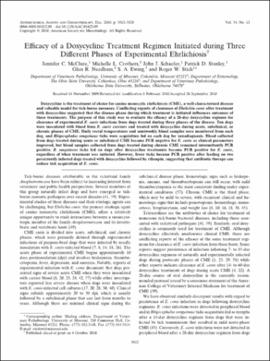| dc.contributor.author | McClure, Jennifer C. | |
| dc.contributor.author | Crothers, Michelle L. | |
| dc.contributor.author | Schaefer, John J. | |
| dc.contributor.author | Stanley, Patrick D. | |
| dc.contributor.author | Needham, Glen R. | |
| dc.contributor.author | Ewing, S. A. | |
| dc.contributor.author | Stich, Roger W. | |
| dc.date.accessioned | 2018-08-17T16:24:54Z | |
| dc.date.available | 2018-08-17T16:24:54Z | |
| dc.date.issued | 2010-12 | |
| dc.identifier | oksd_mcclure_efficacyofadoxy_2010 | |
| dc.identifier.citation | McClure, J. C., Crothers, M. L., Schaefer, J. J., Stanley, P. D., Needham, G. R., Ewing, S. A., & Stich, R. W. (2010). Efficacy of a doxycycline treatment regimen initiated during three different phases of experimental ehrlichiosis. Antimicrobial Agents and Chemotherapy, 54(12), 5012-5020. https://doi.org/10.1128/AAC.01622-09 | |
| dc.identifier.uri | https://hdl.handle.net/11244/301443 | |
| dc.description.abstract | Doxycycline is the treatment of choice for canine monocytic ehrlichiosis (CME), a well-characterized disease and valuable model for tick-borne zoonoses. Conflicting reports of clearance of Ehrlichia canis after treatment with doxycycline suggested that the disease phase during which treatment is initiated influences outcomes of these treatments. The purpose of this study was to evaluate the efficacy of a 28-day doxycycline regimen for clearance of experimental E. canis infections from dogs treated during three phases of the disease. Ten dogs were inoculated with blood from E. canis carriers and treated with doxycycline during acute, subclinical, or chronic phases of CME. Daily rectal temperatures and semiweekly blood samples were monitored from each dog, and Rhipicephalus sanguineus ticks were acquisition fed on each dog for xenodiagnosis. Blood collected from dogs treated during acute or subclinical CME became PCR negative for E. canis as clinical parameters improved, but blood samples collected from dogs treated during chronic CME remained intermittently PCR positive. R. sanguineus ticks fed on dogs after doxycycline treatments became PCR positive for E. canis, regardless of when treatment was initiated. However, fewer ticks became PCR positive after feeding on two persistently infected dogs treated with doxycycline followed by rifampin, suggesting that antibiotic therapy can reduce tick acquisition of E. canis. | |
| dc.format | application/pdf | |
| dc.language | en_US | |
| dc.publisher | American Society for Microbiology | |
| dc.rights | This material has been previously published. In the Oklahoma State University Library's institutional repository this version is made available through the open access principles and the terms of agreement/consent between the author(s) and the publisher. The permission policy on the use, reproduction or distribution of the material falls under fair use for educational, scholarship, and research purposes. Contact Digital Resources and Discovery Services at lib-dls@okstate.edu or 405-744-9161 for further information. | |
| dc.title | Efficacy of a doxycycline treatment regimen initiated during three different phases of experimental ehrlichiosis | |
| osu.filename | oksd_mcclure_efficacyofadoxy_2010.pdf | |
| dc.description.peerreview | Peer reviewed | |
| dc.identifier.doi | 10.1128/AAC.01622-09 | |
| dc.description.department | Veterinary Pathobiology | |
| dc.type.genre | Article | |
| dc.type.material | Text | |
| dc.subject.keywords | antibiotic | |
| dc.subject.keywords | antibacterial agent | |
| dc.subject.keywords | ehrlichia infection | |
| dc.subject.keywords | therapeutic protocol | |
| dc.subject.keywords | treatment | |
| dc.subject.keywords | doxycycline | |
| dc.subject.keywords | treatment efficiency | |
| dc.subject.keywords | protein synthesis inhibitor | |
| dc.subject.keywords | tetracycline derivatives | |
| dc.subject.keywords | infection | |
| dc.subject.keywords | bacteriosis | |
| dc.subject.keywords | rickettsialosis | |
